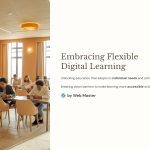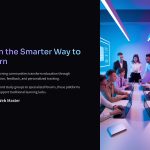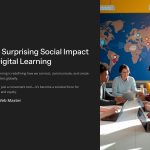 In today’s fast-paced world, the demand for education that adapts to individual needs and schedules is more prominent than ever. Flexible digital learning offers a solution by providing learners with the autonomy to choose what, how, when, and where they study. This approach not only caters to diverse learning styles but also breaks down traditional barriers to education, making it more accessible and inclusive. As technology continues to evolve, the integration of AI, virtual reality, and personalized learning paths is set to further enhance the digital learning experience, promising a future where education is tailored to each learner’s unique journey.
In today’s fast-paced world, the demand for education that adapts to individual needs and schedules is more prominent than ever. Flexible digital learning offers a solution by providing learners with the autonomy to choose what, how, when, and where they study. This approach not only caters to diverse learning styles but also breaks down traditional barriers to education, making it more accessible and inclusive. As technology continues to evolve, the integration of AI, virtual reality, and personalized learning paths is set to further enhance the digital learning experience, promising a future where education is tailored to each learner’s unique journey.

Understanding Flexible Digital Learning
Flexible digital learning refers to educational methods that leverage digital platforms to provide learners with control over various aspects of their education, including content, pace, time, and location. This approach contrasts with traditional, rigid educational structures by offering a more personalized and adaptable learning experience. citeturn0search0
Key characteristics include:
- Personalized Learning Paths: Learners can select courses and materials that align with their interests and career goals.
- Self-Paced Study: Individuals have the freedom to progress through content at a speed that suits their comprehension and schedule.
- Accessibility: Digital platforms enable access to education regardless of geographical location, time constraints, or physical limitations.

Benefits of Flexible Digital Learning
The advantages of adopting flexible digital learning are numerous:
- Enhanced Accessibility: By removing geographical and time barriers, education becomes available to a broader audience, including those in remote areas or with demanding schedules. citeturn0search2
- Cost-Effectiveness: Digital learning often reduces or eliminates expenses related to physical materials, commuting, and accommodation, making education more affordable.
- Skill Development: Encourages self-discipline, time management, and digital literacy—skills that are highly valued in today’s job market.
- Diverse Learning Resources: Access to a wide array of multimedia resources caters to different learning styles, enhancing understanding and retention.

Emerging Trends in Flexible Digital Learning
As technology advances, several trends are shaping the future of flexible digital learning:
- Artificial Intelligence (AI) Integration: AI is being used to create adaptive learning environments that respond to the individual needs of learners, providing personalized feedback and support. citeturn0search1
- Microlearning: The delivery of content in small, manageable units allows learners to engage with material in short bursts, fitting education into even the busiest schedules. citeturn0search5
- Virtual and Augmented Reality (VR/AR): These technologies offer immersive learning experiences, particularly beneficial in fields requiring practical, hands-on training.
- Collaborative Platforms: Online forums and group projects facilitate interaction among learners worldwide, fostering a sense of community and shared knowledge.

Challenges and Considerations
While flexible digital learning offers numerous benefits, it also presents certain challenges:
- Self-Motivation Required: The autonomy of digital learning demands a high level of self-discipline and motivation from learners.
- Digital Divide: Not all individuals have equal access to the necessary technology and internet connectivity, potentially exacerbating educational inequalities.
- Quality Assurance: Ensuring the credibility and quality of online courses and materials can be challenging, necessitating thorough research before enrollment.

Implementing Flexible Digital Learning in Your Life
To effectively incorporate flexible digital learning into your educational journey:
- Set Clear Goals: Define what you aim to achieve to select the most relevant courses and resources.
- Create a Structured Schedule: Allocate specific times for study to maintain consistency and progress.
- Utilize Available Resources: Take advantage of the diverse materials and support systems offered by digital platforms.
- Stay Engaged: Participate in online discussions and collaborative projects to enhance understanding and build connections.

The Future of Flexible Digital Learning
The trajectory of flexible digital learning points towards an increasingly personalized and accessible educational landscape. Innovations in AI, VR/AR, and data analytics are set to further tailor learning experiences to individual needs. Moreover, the growing recognition of digital credentials by employers is enhancing the legitimacy and appeal of online education. As these trends continue to evolve, flexible digital learning stands to play a pivotal role in democratizing education and fostering lifelong learning.
*Capturing unauthorized images is prohibited*







